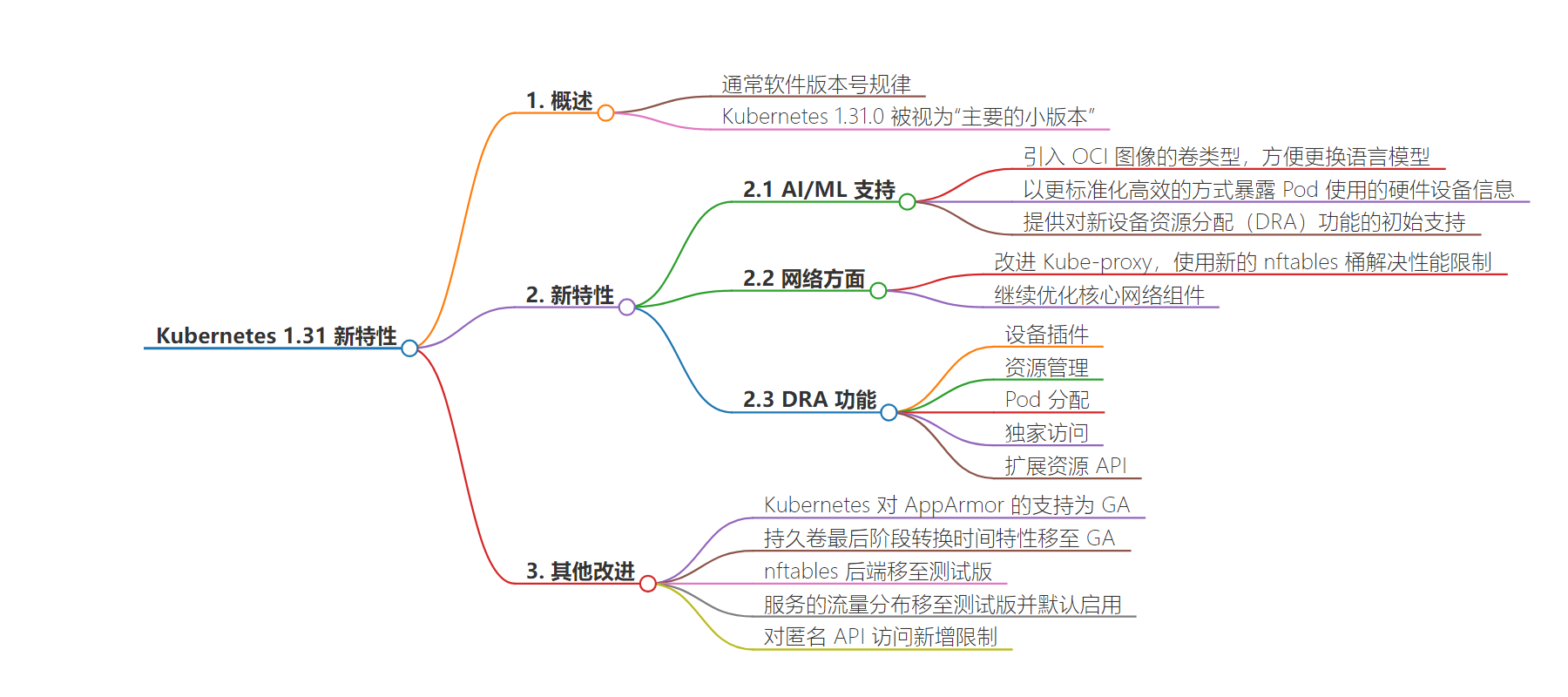包阅导读总结
1.
– `Kubernetes 1.31`、`AI/ML 支持`、`网络改进`、`设备资源分配`、`版本更新`
2.
Kubernetes 1.31 发布,被视为重要的小版本更新,在支持 AI/ML 工作负载处理和网络方面有显著进步,包括新的卷类型、硬件设备信息暴露及新的网络组件改进等。
3.
– Kubernetes 1.31 发布
– 介绍:通常软件版本号复杂不被视为“重大”发布,但此版本很重要
– 特点:开源平台,用于自动化容器化应用的部署、扩展和管理
– 新特性
– AI/ML 支持
– 引入 OCI 图像卷类型,便于更改模型
– 以更标准高效方式暴露硬件设备信息
– 提供对新 DRA 特征的初始支持
– 网络改进
– 改进 Kube-proxy,增加新 nftables 桶解决性能限制
– 继续优化核心网络组件
– 其他改进
– Kubernetes 对 AppArmor 的支持达到 GA
– 一些功能的阶段转变和新限制
思维导图:
文章地址:https://thenewstack.io/kubernetes-1-31-arrives-with-new-support-for-ai-ml-networking/
文章来源:thenewstack.io
作者:Chris J. Preimesberger
发布时间:2024/8/14 0:19
语言:英文
总字数:670字
预计阅读时间:3分钟
评分:87分
标签:Kubernetes,人工智能/机器学习,网络,OCI 镜像,设备资源分配
以下为原文内容
本内容来源于用户推荐转载,旨在分享知识与观点,如有侵权请联系删除 联系邮箱 media@ilingban.com
Normally, a software release with a lot of version numbers in it isn’t what’s considered a “major” release. That’s known as a “point” release. The big ones are usually relegated to simple X.0 or XX.0 designations.
Well, don’t be fooled by overlooking Kubernetes’ v1.31.0, which became generally available today. Its release leader, Angelos Kolaitis, says he considers this a “major minor release,” and that it’s important enough to warrant more than cursory attention.
Kubernetes, also known as K8s and originally developed by Google, is an open source platform designed to automate the deployment, scaling and management of containerized applications. It has skyrocketed in popularity and production use in IT systems in the last decade.
This latest edition (Kubernetes churns out three versions a year on a disciplined schedule) represents significant advancements in support of AI/ML workload processing and in networking generally, Kolaitis said.
New Attributes of Kubernetes 1.31.0
For support of AI/ML workloads, v1.31.0 introduces a volume type for (OCI) images, which enables developers to easily change a large language model used in a workload by simply changing out its image. OCI images are now used as volume sources in Kubernetes, so changing models or model weights is simplified.
“Developers using one particular model now can just change some OCI elements in the same way that they already know how to change images – for deployments when you want to upgrade or when you want to try something new. This is a very familiar process,” Kolaitis said.
OCI (Open Container Initiative) refers to a set of open standards and specifications that govern the creation, distribution and execution of container images.
The new edition exposes information about hardware devices used by pods, such as GPUs, in a more standardized and efficient way. Finally, it provides initial support for the new Device Resource Assignment (DRA) feature, which helps standardize the process of accessing and managing hardware accelerators, such as GPUs.
In networking, v1.31.0 improves Kube-proxy, a critical network component responsible for service discovery and load balancing within a cluster, with a new nftables bucket, which helps address performance limitations. Buckets are used to implement rate limiting and traffic-shaping mechanisms in nftables. They help prevent network congestion, ensure fair bandwidth allocation and protect against potential attacks, such as denial of service (DoS).
The new edition also continues to streamline and stabilize its core networking components, providing more reliability and robustness without requiring changes from users, Kolaitis said.
What Does DRA Do?
The Device Resource Assignment (DRA) feature is an important step forward in standardizing the process of accessing hardware accelerators, Kolaitis said. DRA enables the allocation and management of hardware devices, such as GPUs, field-programmable gate arrays (FPGAs) or network interface cards (NICs), to specific pods much more efficiently.
Key data points about DRA:
- Device plugins: Kubernetes DRA uses device plugins to interface with the underlying hardware and make devices discoverable by the cluster.
- Resource management: Once devices are recognized, they become manageable resources within Kubernetes, similar to CPU or memory.
- Pod assignment: Users can request specific devices or device quantities in their pod specifications, and Kubernetes’ scheduler attempts to place those pods on nodes with matching available devices.
- Exclusive access: DRA ensures exclusive access to assigned devices, preventing multiple pods from contending for the same hardware resource.
- Extended resource API: The extended resource API in Kubernetes enables the representation and allocation of these specialized hardware devices.
Other Improvements in Kubernetes 1.31
Other improvements in v1.31.0 include:
- Kubernetes support for AppArmor is now GA.
- Persistent Volume last phase transition time feature moved to GA in v1.31.
- The nftables backend moves to beta in v1.31, behind a newly added feature gate.
- Traffic distribution for Services moves to beta in v1.31 and is enabled by default.
- New restrictions included on anonymous API access.
Go here to access the complete blog post detailing the v1.31.0 release.
Go here for the GitHub release notes.
YOUTUBE.COM/THENEWSTACK
Tech moves fast, don’t miss an episode. Subscribe to our YouTubechannel to stream all our podcasts, interviews, demos, and more.
